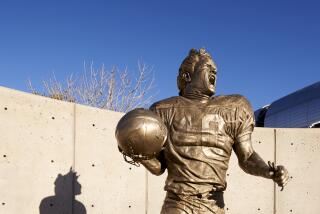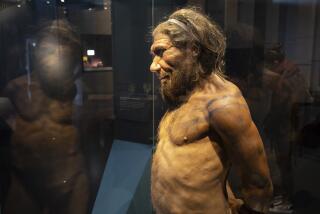In Search of a Great Myth and the North Pole
- Share via
In Arlington National Cemetery, above the grave of explorer Robert E. Peary, stands a white granite globe with the inscription Inveniam Viam Aut Facium. “I shall find a way or make one.”
Perhaps.
The imposing gravestone remains less a monument to a great discovery than a monument to a great myth or, more precisely, our need to believe in great myths. And great men.
Although stalwarts still defend Peary--the National Geographic Society maintains that he came within a few miles of the North Pole--persuasive research suggests he never made it. Neither, it seems, did his rival, Dr. Frederick Cook, who claimed just five days before Peary’s announcement that he had discovered the pole the year before.
But in 1909, the question wasn’t whether humans had captured the North Pole. After all, the Wright brothers had achieved flight six years earlier, so anything was possible. The question was who reached the pole first, and the squabbling started immediately.
Two days after this front page, The Times quoted the pro-Cook president of the Arctic Club of America, who labeled Peary “a colossal faker.” Meanwhile, a veteran of an earlier Peary expedition insisted: “If Peary says he has reached the North Pole, depend upon it.”
The controversy would follow Cook and Peary to their graves--literally. Cook’s headstone features no granite globe but says he is “recognized by many as the first discoverer of the North Pole.”
To understand the rancor of the rivalry, one must remember that Peary and Cook were men of the 19th century, inheritors of a grand tradition of discovery. As Robert M. Bryce, author of “Cook & Peary,” notes: “The mad dreamers of the North Pole dreamed the dream of accomplishing one last heroic deed--to breathe the frozen winds of the unknown North--to seize the White Grail--to exhale the last great heroic gasp before the spirit of the romantic age departed . . . forever.”
And so these brave and driven men risked all to reach a spot that is 400 miles from land. Unlike the South Pole, which lies in the heart of a continent and where some wag has erected a real pole, the North Pole is a man-made convention hovering above shifting ice floes. It’s not Mt. Everest. It’s a dot on a map.
So why the relentless effort to find it, and the nasty debate over who stood there first? Bryce suggests that the answer lies in our need to believe that we, and not nature, are in control, that the human race can make the impossible possible. We love heroes. And a good story.
“It testifies,” Bryce writes of the Cook / Peary dispute, “to the power of faith and the tenaciousness of belief, and it strikes at the human heart’s basic need for the assurance that the affairs of men are orderly.”
*
And so the Peary mystique hangs on. If anything, his story has been enhanced by well-intentioned efforts to honor his companion on the pole expedition, Matthew Henson, who for decades received little, if any, notice. Indeed, this edition of The Times mentions him only in a 94-word story--buried inside--under the questioning headline “NEGRO AT POLE?”
The story, which identifies Henson as Peary’s “negro body servant,” observes: “If he lives he has been at the pole with his commander, the first member of his race.” The “if he lives” refers to Peary’s terse initial telegrams, which omitted the status of his party. The brief story on Henson may have been condescending, but it was, at least, a mention.
Henson’s story is perhaps more extraordinary than the race for the pole. Born a year after the Civil War and orphaned young, he sailed out of Baltimore aboard a merchant ship at age 12. He traveled the world, learning Mandarin and an Eskimo language along the way. Peary said of him: “He must stay with me. I cannot get along without him.”
Henson died in 1955, 35 years after Peary. In 1988 his remains were moved from a New York cemetery and reinterred in Arlington, next to Peary. Last year, the Navy named a research vessel after him.
The attention is deserved. Even if Peary and Henson never reached the pole, they certainly pushed the boundaries of human endurance. Although history finally recognized Henson, it still does not honor their four Eskimo companions. Henson may have earned only 94 words in this newspaper, but the Eskimos got nothing.
Henson, however, would describe the men later in his book “Henson: A Negro Explorer at the Pole.” They were the sturdy and boyish Ooqueah, loyal Seegloo, and the brothers Egingwah and Ootah, the latter known as a kind father and great hunter. If we must believe in great myths and great men, these should be included as well.
About This Series
For the remainder of the year and ending Jan. 1, 2000, The Times will reproduce a page from its archives recording events that shaped the history of the 20th century. An accompanying essay will help place the events in historical context.
Many major moments were fully covered in The Times. Yet the pages also illustrate the limitations of newspapers as omniscient chroniclers. Albert Einstein’s publication of the general theory of relativity during World War I, for example, did not result in newspaper coverage until many years later.
Although the pages will be published sequentially, not every year will be represented. Any list of this sort is necessarily subjective. The editors sought a balance of local, national, international and cultural events to provide current readers with a sense of how The Times covered the century.
To supplement that effort, we invite your participation. In 200 words or less, send us your memories, comments or eyewitness accounts of events you believe shaped the century. We will publish as many as we can on this page until the end of the year. Write to Century, Los Angeles Times, Times Mirror Square, Los Angeles, CA 90053, or e-mail [email protected]. Because of the volume of mail, we regret we cannot acknowledge individual submissions.
More to Read
Sign up for Essential California
The most important California stories and recommendations in your inbox every morning.
You may occasionally receive promotional content from the Los Angeles Times.










